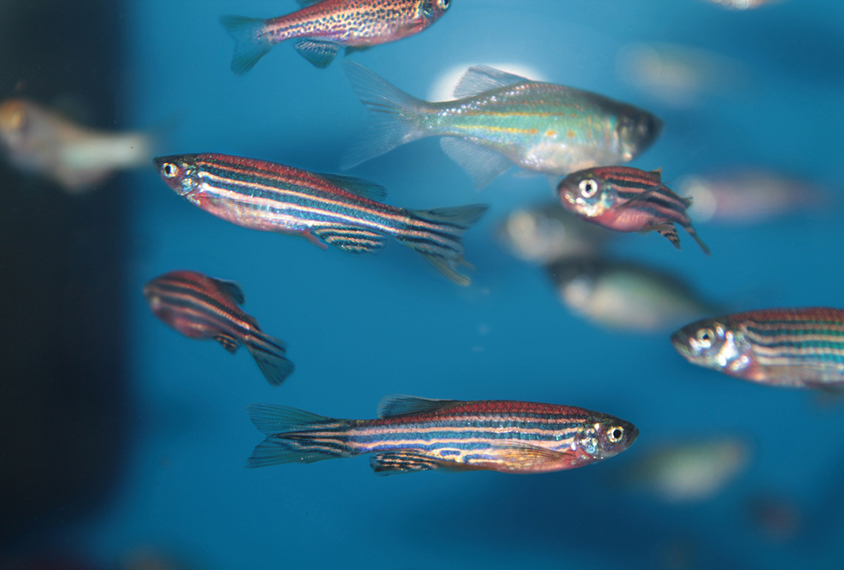
Kazakov Maksim / shutterstock
SHANK3 zebrafish may be too cool for schools
Zebrafish lacking the autism-linked gene SHANK3 show little social interest and other behavioral abnormalities.
Zebrafish lacking the autism-linked gene SHANK3 show little interest in interacting with other fish and other unusual social tendencies. Researchers presented the unpublished findings today at the 2017 Society for Neuroscience annual meeting in Washington, D.C.
SHANK3 mutations occur in 1 to 2 percent of individuals with autism. Zebrafish have been used to study developmental and motor abnormalities related to autism-linked genes. The new findings hint that the fish could also help scientists understand social deficits in autism.
Zebrafish have a rich repertoire of social behavior. They form large groups, called shoals, that provide protection from predators in the wild. They engage in dominance displays such as swimming rapidly toward another fish, and submissive ‘freezing’ after being chased off by a dominant fish.
“They are constantly trying to find a way to interact with other fish,” says study leader Jagmeet Kanwal, associate professor of neurology at Georgetown University in Washington, D.C. “It’s so powerful, their social attraction.”
Walking through the poster hall, David Beversdorf, associate professor of psychology at the University of Missouri, was drawn to the idea of studying social behavior in a fish model of autism.
“Is this the first social task for zebrafish?” he asks. (It’s not — but as an autism model, the fish are offbeat.) “That’s cool!” he says of the new experiments.
Swimming socially:
In one experiment, Kanwal and his team tested two SHANK3 mutants and three controls in a maze in which other fish are visible at some places but not at others. Within about an hour, controls learn how to circle through the maze so that they spend more time with other fish in view than out of view. “They are very clever,” Kanwal says.
But the zebrafish lacking SHANK3 tend to stay at the start of the maze, and when they do enter, they show no preference for the social zone.
In another experiment, the researchers tracked the movements of two mutants and four controls in a tank containing two smaller tanks, one empty and one occupied by two or three other zebrafish. Control fish spend most of their time near the chamber containing the other zebrafish, which probably reflects shoaling behavior.
“Shoaling behavior is an important indicator of social tendencies,” says Andrew Velkey, director of the neuroscience program at Christopher Newport University in Newport News, Virginia, who was not involved in the work. Velkey studies social behavior in zebrafish, but his studies are not related to autism.
Speed dating:
The SHANK3 fish spend less time around the social tank than control fish do. “It actually is delayed in being attracted to the conspecific and disengages sooner,” says Saman Asdjodi, a student at Georgetown University School of Medicine, who presented some of the Kanwal team’s findings.
The mutants also swim more slowly toward the social tank. Their speed clocked in at 13.7 millimeters per second, compared with 19.7 millimeters per second for controls.
The SHANK3 fish don’t display dominance by dashing toward other fish. They also exhibit ‘freezing’ behavior when they haven’t lost a dominance contest.
Zebrafish hold promise for screening drugs because they cost little to maintain and they reproduce quickly, Beversdorf says.
Still, the zebrafish brain is different from the brains of mammals, and there is no good atlas of its anatomy. Kanwal is working with neuroanatomists to map social brain regions in the SHANK3 fish and note any unusual features.
For more reports from the 2017 Society for Neuroscience annual meeting, please click here.
Recommended reading

Expediting clinical trials for profound autism: Q&A with Matthew State

Too much or too little brain synchrony may underlie autism subtypes
Explore more from The Transmitter

This paper changed my life: Shane Liddelow on two papers that upended astrocyte research
Dean Buonomano explores the concept of time in neuroscience and physics

